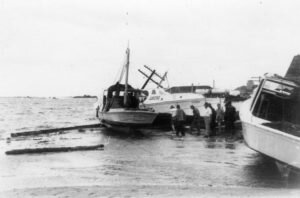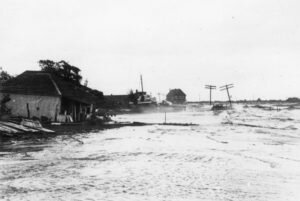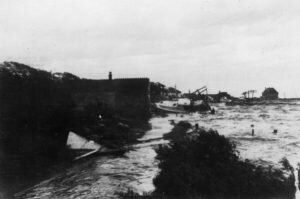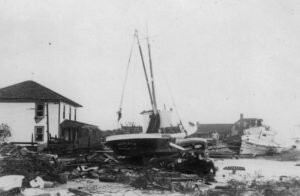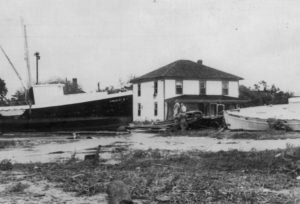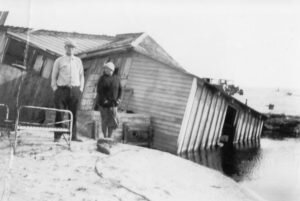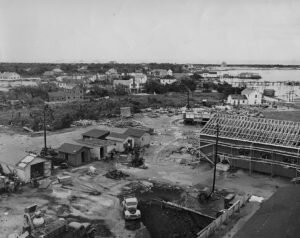June 2016 Exhibit, Hurricanes
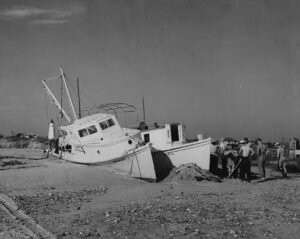 June 1st is the official start of hurricane season for the Atlantic, we are going to concentrate on the Great Hurricane of 44′ for this particular exhibit since it was one of the strongest and most damaging storms in Ocracoke’s history.
June 1st is the official start of hurricane season for the Atlantic, we are going to concentrate on the Great Hurricane of 44′ for this particular exhibit since it was one of the strongest and most damaging storms in Ocracoke’s history.
“They brew out of the heat of the tropics, spinning blindly across the open sea. Often they evolve into massive storms with violent winds and torrential rains. They may live for days or for weeks, and most die off harmlessly as they wander over cooler waters. Some cause widespread alarm by tracking unpredictably close to land. We plot their growth, give them names, and track their movements across the sea. But occasionally, these storms become deadly intruders as they strike our coastline with random fury. Hurricanes, and their counterparts around the globe, are the greatest storms on earth, killing more people worldwide than all other storms combined.
In North Carolina, the 44′ storm was called the “worst ever” by some on the Outer banks, who again watched as the ocean and sound met, surrounding their homes with water. On Ocracoke the tide rose two to four feet in many houses. As they had done so many times in the past, residents there opened their doors to the rising waters to keep their homes in place. Fish were reportedly trapped under furniture and left behind when the storm passed and the waters receded.
The hurricane moved northward up the banks at about 30mph on the morning of September, 14. At Cape Hatteras , the weather station recorded a barometric pressure reading of 27.97 inches, the lowest to date for that location. Even though its center remained at sea, the storm’s massive eye wobbled up Hatteras Island and was discernible to the island’s residents. It was reported that the eye was so large that many had time to leave their homes to check on their boats, visit friends, and survey the damages in the area. Some were caught off guard when the hurricane’s eye passed by and the winds exceeding 100mph “hauled around” blowing from the northwest.
Although only one North Carolinian was killed in the Great Atlantic Hurricane of 1944, the storm was deadly overall. In the northeast, 45 more lives were lost, including 26 in Massachusetts. But most tragically, 344 more people died at sea as five ships sank during the hurricane. Two of those were lost off of the North Carolina coast.” -North Carolina Hurricane History book (3rd edition)
Photos below are from the Bertha O’neal & Donald Northam Collections are of the damage in Ocracoke Village.
Below is a storm account that was written on a wall in a soundside home during the event of September 13, 1944
|
*Storm Warning-September 13, 1944
Day calm and hot. In evening, 14 fishboats came into lake for shelter. September 14 5 a.m. Winds rising:Northeast 7 a.m. Winds reached 75 knots. Anemometer on water tower at Naval Base carried away. Later winds estimated at 100 knots. Barometer 28.40. 7:30 a. m. Winds shift to Northwest. 14 foot tides. Island completely under water. Most fishing boats blown far ashore, causing considerable damage to boats and docks. Mailboat tossed ashore close to coffee shop (Island Inn). Six houses completely demolished Pamlico Inn damaged beyond repair. Extensive damage done to Gary Bragg’s home. 3 feet of water pounding through this cottage. Porch blown off and front windows shattered, and front door blown in. Practically all furniture upturned and much of it washed into kitchen. Kitchen window smashed. Front room floor torn up. 9:25 a.m. Wind Velocity dropped. Completely calm by 12:30 p.m. Far worst storm ever to strike island. No lives lost.* |
David Batterson, a Navy corpsman, stationed on Ocracoke from 1943-45, was living in private housing when the ’44 storm hit. He and his wife, Helen, rented a small house right on the harbor near the present day Silver Lake Inn. Here are his recollections of their experience with that devastating hurricane, which howled across the island on September 14, 1944.
” The storm hit early on that Saturday morning, shoving a fishing boat through the front of our house, stopping just short of where we were sleeping. The water kept getting higher, and the wind increased to the point where we felt we’d be safer on higher ground. We grabbed what we could carry and headed for the Navy Base. We waded through shoulder-high water, carrying a few dry clothes in a suitcase held as high as possible above my shoulders with one hand and hanging on to my wife’s hand with the other. people in two-story houses who saw us motioned to come to their place, but with large pieces of lumber and all types of debris floating past us, somehow we felt we wanted to be with others at the base, and so we struggled slowly forward. We were walking against a current of water being driven by wind at a force of 110 miles per hour. We arrived at the entry gate outside the base near Stanly Wahab’s house (This is the large white house, set back a bit from Hwy 12, next door to the Berkley Manor Bed & Breakfast.) My wife’s shoes were washed off her feet as we went up the steps to a loading dock at the base. We were totally exhausted. There was a military truck parked next to a large warehouse, and we crawled up into it. Not another soul in sight, but I honked the horn and a warehouse door opened and a Navy Chief saw us and helped us inside.
My wife was helped onto the top of a desk, and when that started floating, the four men inside this huge building said, “You’d better climb that ladder to the loft and put on some dry clothes if you have any.” We did that and just huddled together, expecting to be washed away if the storm continued much longer. By some miracle, though, the water started receding and went down very quickly. We then made it to “sick bay” and my wife was put to bed, where she remained a few days with a bad cold. The fishing boat that washed ashore destroyed most of our house, with many of our personal belongings going back out to sea. We had piled as many as possible on top of the bed and chest, but also had several unpacked boxes which my wife had brought from California, not knowing the living conditions she was coming to. Words can’t describe the odor of dead fish, animals, chickens, etc., which combined with the flooded outhouses, filled the air.
There were so many stranded people at the base, they were sleeping on cots in all the hallways for several days, most of all with a case of diarrhea from polluted water, and the doctor and pharmacist mated were working around the clock. The navy ran crash boats to shore as soon as possible to evacuate any wives and children who wanted to leave, and many did. Because we were from California and had been separated most of the time since our marriage in November 1942, my wife wanted to say.”
Previous Exhibits Below-
December Online Exhibit 2016 US Navy Base Ocracoke
November Online Exhibit 2016 Ocracoke Post Office
October Online Exhibit 2016 Dare Wright
September Online Exhibit 2016 Ocracoke School
August Online Exhibit 2016 Robbie’s Way
July Online Exhibit 2016 4th of July History
May Online Exhibit 2016 Island Architecture
April Online Exhibit 2016 Charlie Ahman
March Online Exhibit 2016 Frank Treat Fulcher
February 2016 Online Exhibit Muzel Bryant
January 2016 Online Exhibit The Cochrans
December 2015 Online Exhibit JoKo Artist
